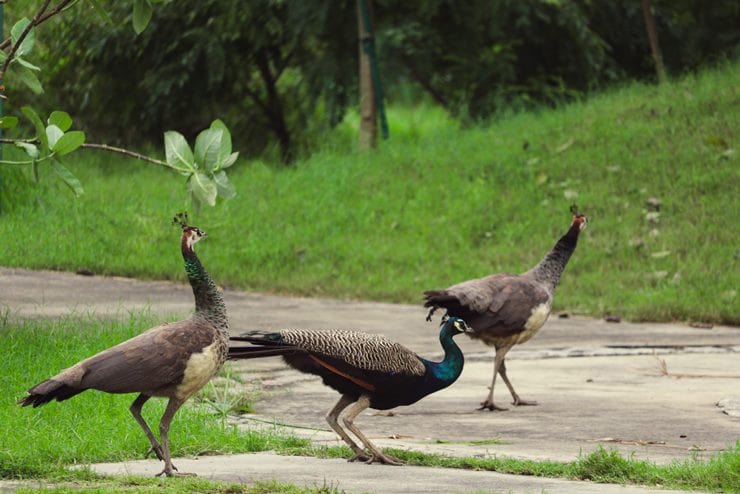Peacocks are colorful birds with iridescent green and blue feathers. Of the three extant species, two are found in India and Southeast Asia, while one is found in the Congo Basin of Africa.
Table of Contents
The name peacock is what these birds are commonly called, but the correct name for this species is peafowl. A peacock is the brightly-colored male peafowl, while peahen refers to the more drably-colored female.
The most common collective noun for a group of peacocks is “Ostentation”.
Additional collective nouns for this bird include:
- Pride
- Muster
- Party
- Pulchritude
- Crowd
- Pstemtatopm
- Bevy
The Indian Peafowl is the most widely recognized peacock, with its iridescent blue body.
The Green Peafowl from Southeast Asia has a bright green body and is listed as endangered.
The Congo Peafowl has darker feathers mixed with metallic blue and green and is a Vulnerable Species. Neither of these two peafowl species is as well-known as the Indian Peafowl.
Indian Peafowl is a species of Least Concern in their native range. They have been introduced all over the world, providing ornamentation to gardens, zoos, and farms. Some of those introduced birds have become feral and naturalized in new places.
Peacock males have distinctive, vibrantly-colored feathers located above their tails. They are long and can stand up and fan out behind their bodies, giving the appearance of many eyes. Females do not have long feathers above their tails like males.

Also Read: Can Peacocks Fly
What Is A Group of Male Peacocks Called?
Males gather in groups at the beginning of the breeding season to compete for female attention.
These groups of males are usually called a lek. The lek also refers to the area where courtship occurs. Males compete with each other at the lek by shimmering their tails and noisily squawking. Other common collective nouns for male peacocks include a bawl and a cluster.
Male peacocks, a redundant phrase referring to male peafowl, have a long, iridescent train of feathers. Combined with their iridescent body feathers, they can captivate female peacocks during the courtship period by shimmering their feathery train in the sunlight.
The long, heavy train has evolved over time, creating an extreme example of sexual dimorphism, where males look very different from females.
What Is A Group Of Female Peacocks Called?
Female peacocks have dull-colored feathers of brown and gray on their bodies, with iridescent green-blue feathers around their necks. Several females will choose the same male with whom to mate. This practice is called polygyny. For this reason, pairs of peacocks do not usually occur in nature.
The groups of females with each male are often called a harem. These harems stay with the males, foraging, until they lay a clutch of eggs.
At the beginning of the breeding season, females choose a mate based on his plumage. Scientists believe that the rattling and shaking of the long, feathery train of the male peacock is what females are attracted to and helps them determine a male’s fitness.
What is a Group of Baby Peacocks Called?
Females build their nests by scratching a depression into the dirt and lining it with leaves and grasses. These nests are hidden under shrubs to keep predators from finding them. After mating with a male, female peacocks lay a few eggs in the nest and incubate them.
The baby peacocks hatch out after around one month. This group of hatchlings is sometimes referred to as peachicks. Peachicks remain with their mother for about six months. Male birds do not help rear the chicks.
Baby peacocks are drab colored, with none of the sexual dimorphism these birds display as adults. Around five months after hatching, the male peachicks start to get color in their breast feathers.
Juvenile male peachicks start developing their long train of feathers after their first birthday. However, they do not finish growing their complete train of feathers to display until around age three. While some males start mating at age two, most do not begin until age three.
Do Peacocks Flock Together in Groups?
Peacocks are opportunistic omnivores, eating anything they can get into their mouths. They eat insects, amphibians, and reptiles like snakes. The plants they eat include flowers, seeds, and even grains, which are a large part of the diet of captive peacocks.
Peacocks form flocks and forage together in large groups before the breeding season. During the breeding season, they break into smaller flocks of one male and several females. After breeding season, they sometimes flock together in large groups for protection.
